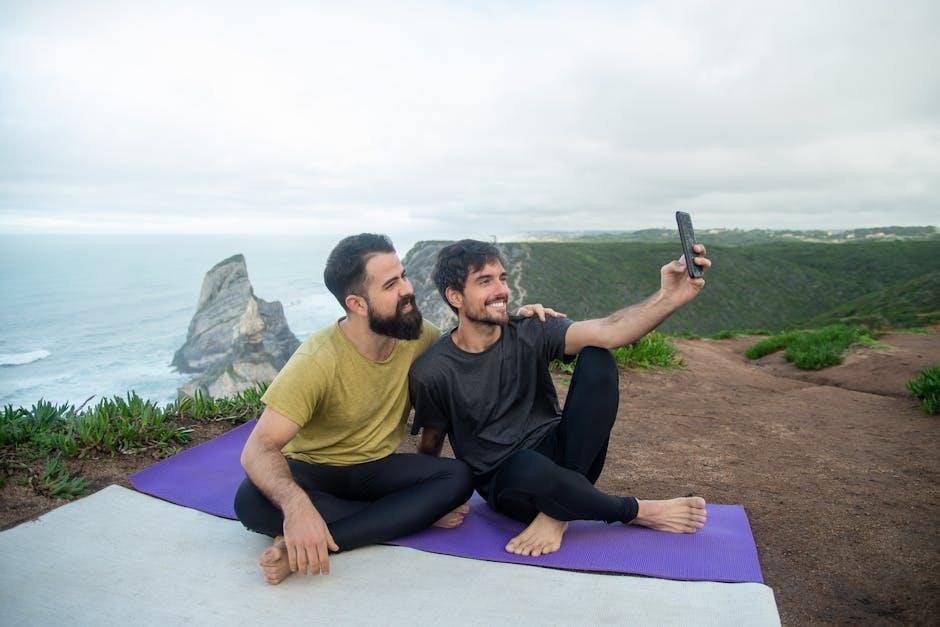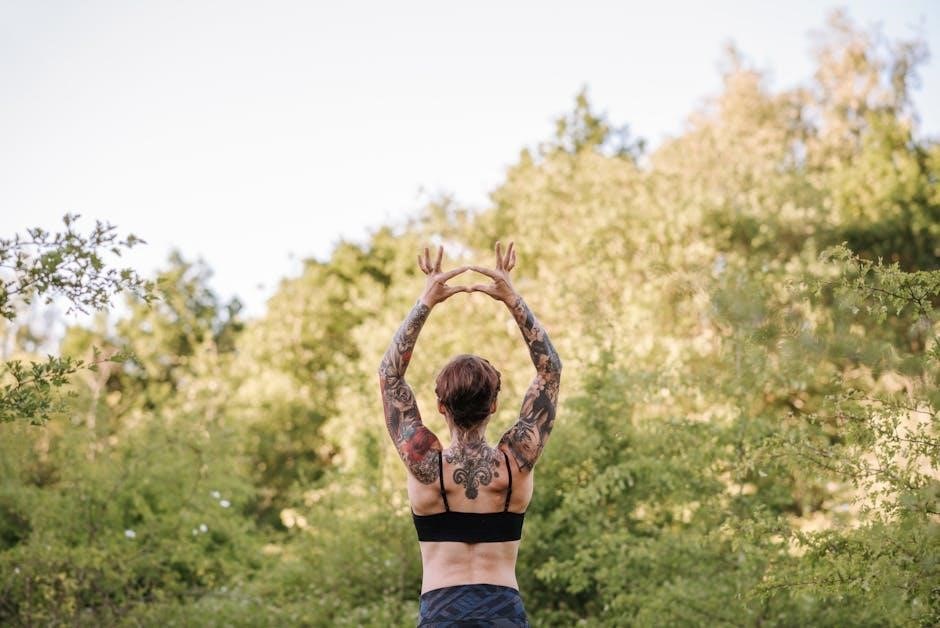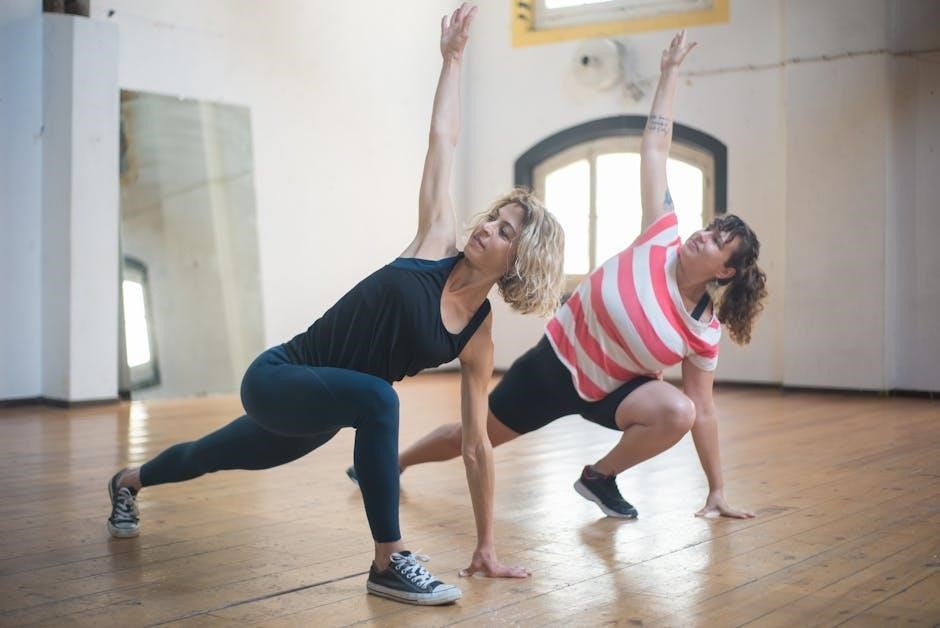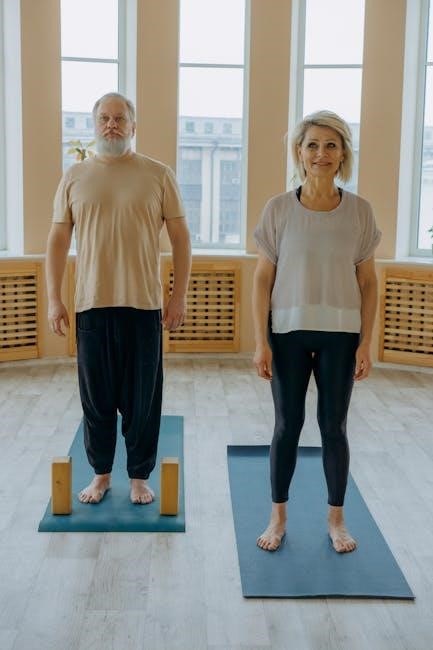
Somatic Yoga is a gentle, therapeutic practice emphasizing slow movements and breath awareness to cultivate body awareness and release tension, promoting overall well-being and emotional balance.
1.1 Definition of Somatic Yoga
Somatic Yoga is a holistic practice that blends traditional yoga with somatic techniques, focusing on internal body awareness and gentle, mindful movements. It emphasizes reconnecting with the body’s inner intelligence, allowing for natural healing and alignment. Unlike traditional yoga, which often focuses on holding static poses, Somatic Yoga encourages dynamic, flowing movements that nurture the connection between the brain, nervous system, and muscles. This practice is designed to retrain the brain-muscle connection, releasing chronic tension and improving flexibility and overall well-being. It is a slow, meditative approach that honors the body’s unique needs and rhythms.
1.2 History and Development of Somatic Yoga

Somatic Yoga emerged from the intersection of ancient yoga practices and modern somatic techniques. Its roots trace back to yoga’s traditional focus on body awareness and breath, while also drawing from the work of 20th-century somatic pioneers like Thomas Hanna. Hanna’s approach to gentle, mindful movements and neural reeducation laid the groundwork for Somatic Yoga. Over time, practitioners integrated these concepts with yoga, creating a unique system that emphasizes internal awareness, slow movements, and releasing tension. This blend of traditions has evolved into a therapeutic practice, widely recognized for its ability to restore balance and promote deep relaxation.
1.3 Key Principles of Somatic Yoga
The core of Somatic Yoga lies in its focus on internal awareness and gentle, intentional movements. It emphasizes the connection between the body and nervous system, encouraging practitioners to listen to their inner sensations. Key principles include slow, mindful actions, neural reeducation, and releasing chronic tension patterns. Unlike traditional yoga, Somatic Yoga prioritizes therapeutic benefits over achieving specific postures. It also highlights the importance of pandiculation, a natural process of contracting and releasing muscles to restore flexibility. This practice is deeply personal, adapting to individual needs and fostering a deeper mind-body connection through subtle, awareness-driven movements.

Principles of Somatic Yoga
Somatic Yoga focuses on internal awareness, gentle movements, and the mind-body connection. It emphasizes pandiculation, neural reeducation, and releasing tension patterns to enhance flexibility and well-being.
2.1 Interoception and Proprioception
Somatic Yoga emphasizes interoception and proprioception as foundational principles. Interoception involves sensing internal bodily states, such as pain, hunger, or relaxation, fostering self-awareness. Proprioception, the sense of body position and movement, guides precise, mindful actions. Together, these senses help practitioners connect with their body’s internal signals, allowing for gentle, intentional movements. This awareness enables individuals to release tension, improve posture, and enhance motor control. By tuning into these senses, Somatic Yoga encourages a deeper understanding of the body’s needs, promoting harmony and balance in practice.
2.2 Nervous System Attunement
Nervous system attunement is a core aspect of Somatic Yoga, focusing on harmonizing the body’s nervous responses. By practicing gentle, mindful movements, individuals can calm the nervous system, reducing stress and anxiety. Techniques such as slow, intentional breathing and soft muscle engagements help regulate the parasympathetic and sympathetic systems. This balance fosters relaxation, improves sleep quality, and enhances emotional resilience. Somatic Yoga encourages awareness of nervous system states, allowing practitioners to adapt their practice for optimal well-being. This attunement is key to creating a restorative and rejuvenating experience, making it a cornerstone of Somatic Yoga philosophy.
2.3 Mind-Body Connection
The mind-body connection in Somatic Yoga is cultivated through awareness and intention. By tuning into internal sensations, practitioners develop a deeper understanding of their body’s needs. This connection allows for more intuitive movement, fostering a sense of unity between the mind and body. Somatic practices encourage conscious engagement, helping individuals release tension and embrace fluidity. The mind serves as a guide, directing the body to explore limits gently and respectfully. This harmonious relationship enhances emotional balance, promotes self-awareness, and empowers individuals to take charge of their well-being. The mind-body connection is central to the transformative power of Somatic Yoga.

Benefits of Somatic Yoga
Somatic Yoga enhances flexibility, reduces chronic pain, and improves posture. It fosters relaxation, boosts energy, and strengthens the mind-body connection, promoting overall well-being and resilience naturally.
3.1 Increased Body Awareness
Somatic Yoga cultivates heightened body awareness by encouraging mindfulness of physical sensations. Through gentle, intentional movements, practitioners develop a deeper connection to their body, identifying areas of tension or imbalance. This awareness allows for more efficient movement patterns and improved posture. By paying attention to subtle cues, individuals can address limitations and enhance flexibility; Enhanced body awareness also fosters a greater understanding of personal alignment, empowering practitioners to make informed choices in their daily activities. This mindful approach promotes long-term physical and emotional well-being, making it a cornerstone of Somatic Yoga practice.
3.2 Improved Posture
Somatic Yoga enhances posture by fostering awareness of alignment and releasing chronic muscle tension. Gentle movements and mindful practices help re-educate the body, promoting natural spinal alignment. By strengthening core muscles and improving flexibility, Somatic Yoga reduces slouching and encourages a more upright, balanced stance. Better posture not only alleviates back pain but also improves breathing and confidence. Regular practice helps maintain proper alignment in daily activities, preventing long-term damage from poor postural habits. This mindful approach to posture is a key benefit of Somatic Yoga, contributing to overall physical well-being and grace in movement.
3.3 Reduced Stress and Anxiety
Somatic Yoga effectively reduces stress and anxiety by calming the nervous system and releasing physical tension. Gentle, mindful movements encourage deep relaxation, lowering cortisol levels. By fostering a connection between body and mind, Somatic Yoga helps recognize and release stored stress patterns. Slow, controlled practices create a meditative state, quieting the mind and promoting emotional balance. This approach not only alleviates immediate stress but also builds resilience against future anxiety. Regular practice enhances overall well-being, offering a natural and holistic way to manage stress and cultivate inner peace.
3.4 Personalization of Practice
Somatic Yoga emphasizes personalization, allowing individuals to tailor their practice to unique needs and abilities. This approach encourages self-awareness, enabling practitioners to honor their bodies and modify poses or movements as needed. Props like blankets, blocks, or bolsters can enhance comfort and accessibility. By listening to internal cues, individuals can create a practice that nurtures their physical, emotional, and mental well-being. This adaptability makes Somatic Yoga inclusive and effective for all, fostering a deeper connection to one’s body and promoting long-term health. Personalization ensures each practice is meaningful and transformative, regardless of fitness level or experience.

Common Somatic Movements
Somatic movements focus on enhancing flexibility, balance, and body awareness through gentle, intentional actions. These slow, flowing practices promote deep relaxation and improve overall well-being.
4.1 Rocking Movements
Rocking movements in somatic yoga involve gentle, repetitive motions that promote relaxation, flexibility, and spinal mobility. These movements, such as the pelvic rock or seated spinal rock, help release tension in the muscles and improve body awareness. By engaging with the natural rhythms of the body, rocking movements encourage a deeper connection between the mind and body, fostering a sense of calm and balance. They are particularly effective for enhancing posture, reducing stiffness, and preparing the body for more dynamic poses. Regular practice can lead to increased fluidity and ease in daily movements.
4.2 Spiraling Movements
Spiraling movements in somatic yoga are fluid, rotational motions that mimic the body’s natural curves and patterns. These movements, such as the spinal spiral or arm circles, help release tension in the joints and muscles while improving flexibility and coordination. Spiraling encourages a deeper understanding of the body’s range of motion, fostering greater ease and grace in movement. By engaging with these patterns, practitioners can enhance their posture, reduce stiffness, and cultivate a more balanced and integrated body awareness. These movements are particularly beneficial for improving circulation and promoting relaxation.
4.3 Undulation Movements
Undulation movements in somatic yoga involve flowing, wave-like patterns that engage the entire body. These movements mimic the natural curves and spirals of the spine, promoting flexibility and ease. By gently moving the spine, hips, and limbs in rhythmic waves, practitioners release tension and improve joint mobility. Undulations enhance body awareness, allowing individuals to connect with subtle sensations and release deep-seated stress. These movements are often used to warm up the body, prepare for deeper poses, or as a standalone practice to cultivate fluidity and grace. Regular practice can lead to improved posture, reduced stiffness, and a greater sense of freedom in movement.
4.4 Pulsing Movements
Pulsing movements in somatic yoga involve gentle, rhythmic contractions and releases of specific muscle groups. These subtle actions help release tension, improve circulation, and enhance body awareness. Practitioners engage in small, controlled pulses, often in areas like the arms, legs, or spine, to awaken dormant muscles and promote relaxation. This practice encourages a deeper connection to the body’s internal rhythms, fostering a sense of fluidity and ease. Regular use of pulsing movements can reduce stiffness, improve joint mobility, and create a soothing, meditative state. They are particularly beneficial for those seeking to release chronic tension or improve overall flexibility.

Somatic Yoga Poses for Beginners
Somatic yoga poses for beginners focus on gentle, accessible movements that enhance body awareness and flexibility. These exercises often include slow, controlled flows and breath-focused practices designed to improve posture, reduce muscle tension, and promote relaxation. Ideal for those new to somatic yoga, these foundational poses create a strong base for more advanced practices, helping to cultivate a deeper mind-body connection and improve overall well-being.
5.1 Pelvic Tilt
The Pelvic Tilt is a foundational somatic yoga pose that gently engages the muscles of the lower back and pelvis. It involves lying on your back with knees bent and feet flat on the ground. Slowly tilt your pelvis upwards, flattening your lower back against the mat, then release. This movement enhances spinal flexibility, promotes relaxation, and improves posture. It also increases body awareness and can help ease tension in the lumbar region. Regular practice strengthens the connection between the pelvis and spine, fostering better alignment and reducing discomfort. This pose is ideal for beginners, offering a calming and grounding experience.

5.2 Gentle Warrior Flow
The Pelvic Tilt is a foundational movement in somatic yoga that enhances spinal mobility and awareness. It involves lying on your back with knees bent, feet flat on the ground. Gently tilt your pelvis upwards, allowing your lower back to press into the mat, then release. This movement strengthens the abdominal muscles, improves posture, and reduces lower back tension. By focusing on subtle sensations, it fosters a deeper mind-body connection, making it an excellent starting point for beginners exploring somatic practices.
5.3 Seated Spinal Twist
The Seated Spinal Twist is a gentle, restorative pose that enhances spinal mobility and torso flexibility. Sit comfortably with legs crossed or feet planted on the floor, keeping the spine long. Gently twist your torso to one side, placing your hand on the outer knee or thigh for support. Hold for 30 seconds to a minute, breathing deeply, then slowly release and repeat on the other side. This pose helps release tension, improves posture, and promotes relaxation. It’s ideal for beginners, as it’s easily adaptable to individual flexibility levels.

Somatic Yoga for Trauma Release
Somatic Yoga for Trauma Release focuses on gentle, mindful movements to release stored tension and promote emotional healing. By engaging the nervous system, it creates a safe space for processing and releasing trapped energy, fostering resilience and calm.
6.1 Leg Shaking
Leg shaking is a foundational somatic movement used to release tension stored in the legs and hips. This practice encourages grounding and relaxation by stimulating blood flow and releasing physical stress. Participants stand or sit comfortably, allowing their legs to shake naturally without force. The movement helps quiet the nervous system, promoting emotional release and calming the body. It’s often used in trauma release to reconnect with the body’s innate healing processes. Regular practice can enhance flexibility and reduce muscle stiffness, making it a simple yet powerful tool for somatic healing.
6.2 Body Shaking
Body Shaking is a powerful somatic practice that releases stored tension and trauma in the body. It involves gentle, voluntary shaking movements that stimulate the nervous system, promoting relaxation and restoring vitality. By engaging the body’s natural tremoring response, it helps discharge pent-up energy and stress; This practice is particularly effective for trauma release, as it allows the body to safely process and release physical and emotional blockages. Regular Body Shaking can enhance resilience, improve circulation, and foster a deeper sense of calm and grounding. It is often performed standing or lying down, with slow, rhythmic movements.
6.3 Kneeling Self-Massage
Kneeling self-massage is a gentle somatic practice that combines movement and manual techniques to release tension in the body. Begin by kneeling on a mat with knees slightly apart. Place fists or soft tools on the thighs or hips. Gently press and circle, focusing on areas of tightness. This practice enhances interoception, allowing you to tune into subtle sensations. It promotes relaxation and reduces muscle stiffness. Regular practice can improve mobility and reduce pain. Remember to breathe deeply, as this amplifies the release. This technique is safe and empowering, encouraging self-awareness and healing.

Somatic Yoga for Back Pain Relief
Somatic Yoga offers gentle, therapeutic movements to alleviate back pain. Techniques like Cat-Cow and Gentle Forward Fold promote spinal flexibility and relaxation, enhancing posture and reducing discomfort.
7.1 Cat-Cow Pose
The Cat-Cow Pose, or Marjaryasana-Bitilasana, is a gentle, flowing movement that promotes spinal flexibility and relaxation. It involves transitioning between a rounded “cat” position and an arched “cow” position while on hands and knees. This pose enhances interoception by drawing awareness to the spine’s natural movement. It eases tension in the neck, shoulders, and lower back, making it ideal for back pain relief. By synchronizing breath with movement, it encourages nervous system attunement. Regular practice improves posture and reduces stiffness, fostering a deeper mind-body connection. This pose is a foundation in somatic yoga for its therapeutic benefits.
7.2 Gentle Forward Fold
The Gentle Forward Fold is a foundational somatic yoga pose that promotes relaxation and flexibility while addressing back pain. By gently folding forward from the hips, this pose stretches the hamstrings, calves, and spine, releasing tension. It encourages awareness of the body’s edge, allowing for a deeper connection to sensations. To practice, stand with feet hip-width apart, engage the core, and fold forward slowly, letting the arms hang. Hold for several breaths, focusing on releasing any discomfort. This pose helps improve posture and reduces stiffness, making it an excellent choice for back pain relief. Regular practice enhances flexibility and promotes calmness.
7.3 Knees-to-Chest Rocking
Knees-to-Chest Rocking is a gentle, restorative movement that targets the lower back and pelvis. To practice, lie on your back, hug your knees to your chest, and gently rock from side to side. This movement helps release tension in the spine and hips while promoting relaxation. It is particularly beneficial for easing back pain and improving mobility. By focusing on slow, controlled rocking, you can enhance circulation and reduce stiffness. This pose is accessible for all levels and can be modified by using a bolster or pillow for additional support. Regular practice fosters a deeper connection to your body’s needs.
Somatic Yoga for Emotional Release
Somatic yoga offers gentle techniques to release emotional blockages through mindful movements and breathwork, promoting stress reduction and fostering inner calm and emotional well-being.
8;1 Somatic Practices for Repressed Emotions
Somatic practices offer a gentle approach to release repressed emotions by reconnecting with the body. Techniques like gentle stretching, breathwork, and mindful movement help uncover and process stored emotional tension. By focusing on sensations rather than intensity, individuals can safely access and release emotional blockages. Practices such as slow, intentional movements and pauses allow the body to express and clear repressed emotions. This mindful exploration fosters a deeper connection to emotional states, promoting healing and balance. Somatic yoga encourages emotional release through awareness, creating a safe space for self-expression and inner harmony. Regular practice can lead to profound emotional liberation.
8.2 Somatic Exercises for Anger Release

Somatic yoga offers powerful tools to release anger by connecting with the body’s physical tension. Practices like grounding techniques help anchor the body, reducing emotional intensity. Slow, intentional breathing paired with gentle movements can calm the nervous system. Dynamic exercises, such as slow arm swings or controlled leg kicks, allow the body to express and release pent-up energy. These movements encourage awareness of bodily sensations, helping to process anger in a healthy, constructive way. Regular practice fosters emotional resilience and balance, transforming anger into a source of energy and clarity.
8.3 Somatic Practices for Trauma Healing
Somatic yoga offers gentle, non-invasive practices to support trauma healing by fostering body awareness and release. Techniques like slow, intentional movements and mindful breathing help reconnect with the body, reducing dissociation. Grounding exercises, such as pressing feet into the earth or using weighted blankets, create a sense of safety. These practices encourage the release of stored tension without re-triggering trauma. A qualified therapist can guide individuals through these exercises, ensuring a safe and therapeutic experience. Regular practice can empower individuals to reclaim agency over their bodies and emotions, promoting long-term healing and resilience.
Sequencing Somatic Yoga Poses
Sequencing somatic yoga poses requires intention and awareness. Start with gentle warm-ups, then progress to deeper movements, ensuring a logical flow. Include modifications and pauses for breath, allowing the body to integrate changes. End with calming poses to promote relaxation and reflection. This structured approach enhances the therapeutic benefits and creates a balanced practice. A well-designed sequence in a PDF guide can serve as a valuable resource for home practice, offering clarity and accessibility.
9.1 Creating a Balanced Practice
A balanced Somatic Yoga practice combines gentle movements, mindful breathing, and relaxation. Start with slow, awakening sequences to prepare the body, then progress to more dynamic poses. Include a mix of standing, seated, and lying-down postures to address all body areas. End with calming exercises to enhance relaxation and mind-body connection. This structure ensures a holistic experience, promoting physical ease, mental clarity, and emotional well-being. A balanced practice fosters sustainability and prevents overexertion, making it accessible for all levels of practitioners. Regularity and intentionality are key to reaping long-term benefits.
9.2 Tips for Sequencing
When sequencing somatic yoga poses, start with an intention or goal for the practice. Consider the client’s or practitioner’s needs, such as releasing tension or improving mobility. Begin with gentle, accessible movements to warm up the body, like rocking or undulating. Gradually introduce more complex or targeted poses, ensuring smooth transitions between them. Incorporate breath awareness and pauses to allow the nervous system to integrate changes. End with calming or grounding poses to promote relaxation and closure. Always prioritize individualization, as every body responds differently to movement.
9.3 Example Sequence
A balanced somatic yoga sequence might begin with gentle pelvic tilts to awaken the spine, followed by seated spinal twists to enhance mobility. Transition into a slow, flowing warrior sequence to maintain calm and awareness. Conclude with knees-to-chest rocking to release the lower back, then move into cat-cow pose for spinal flexibility. End with a seated forward fold, holding each pose for 3-5 breaths. This sequence promotes relaxation, alignment, and mind-body connection, ideal for beginners or those seeking therapeutic benefits. Each movement is slow, intentional, and guided by breath awareness.
